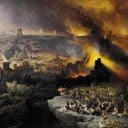THE GREAT CITY
There is no denying that the primary geographical center of the book of Revelation is Jerusalem. It is called Egypt and Sodom as well as Babylon, but it is Jerusalem as the evidence points to. This includes naming it as the “great” city and the city in which the Lord was crucified.
This city also contains the Temple that John is told to measure. This Temple is located in area where Gentiles would be considered “outsiders” as the outer court is reserved for the Gentiles. This could only be Jerusalem.
This city is mentioned over 10 times and is the focus of the judgment and tribulation. It’s walls are torn down and it is overrun by the Gentiles for 3 1/2 years.
At the end of Revelation the earthly city of Jerusalem is contrasted with the heavenly city, then called the New Jerusalem.
ROME
The only other location named or hinted at would be Rome. We find this in Chapter 17 where we are told that the seven heads of the beast represent the seven hills on which it sits. This can only be Rome. The “great” city of Jerusalem is seen as whoring herself with this beast and so at times the imagers merge and blur.
We also know Rome is in view because the seven heads also represent seven king, the sixth of which was alive at the time of the writing of the book.
LAND and SEA
Popular Biblical imagery found throughout the Old Testament is that the “land” represents Israel while the “sea” represents the Gentile nations. This is seen as the Beast comes out of the “sea” while the second beast that has a religious affiliation comes from the land. The land is also seen in conjunction with the term tribes which nearly always be assigned to Israel.
The Greek word “ge” is used for land and it most often represent the “land” of Israel, even when it is translated earth as in the first chapter because of it’s connection to the word “tribes.” These translational issues can make things difficult and the student must be careful to read the contextual issues.
The above is in contrast the other Greek word for earth, “oikemene.” We have discussed this word in detail in previous posts dealing with the Olivet Discourse. I will review here. The term is not meant to be seen as the “entire planet,” but rather the “known” earth, or what we would refer to as the Roman Empire. This is the same word used in Luke 2 to describe the extent of the Roman census under emperor Augustus. We know those in the Philippines, Appalachian Mountains and Alaskan frontier were not taxed be the Romans.
This is simply meant to convey the whole known world at the time of the writing. If the totality of the world was meant to be in focus the author could have used the term “cosmos” which would be the entire world as in Genesis 1.
One other note in relation to the land and sea contrasting, there is one great picture sometimes overlooked. This is found in Revelation 10.
Rev 10:1 Then I saw another mighty angel coming down from heaven, wrapped in a cloud, with a rainbow over his head, and his face was like the sun, and his legs like pillars of fire. 2 He had a little scroll open in his hand. And he set his right foot on the sea, and his left foot on the land
This “angel” is obviously Jesus Christ as the description plainly points. Note where Jesus is standing? He has placed His feet on both the land and the sea showing His dominion and Lordship over both. This great and wonderful picture declares the complete reign of Christ over all things.
ARMAGEDDON
Since there has been a lengthy discussion regarding Armageddon in previous posts I will only state that here you have both a physical and symbolic option. The mention of this plain can simply refer to the actual place and a future or past battle, or it may be symbolic of the demise of Israel which has historic implications.
One note though is that the word for Armageddon is most commonly translated from the word Har-megeddo which would be hill or mountain of Megiddo. This actually may be related to Mt. Carmel. Either way, context must be king and the student must be diligent to discover the true import of the place.
Geography does play a major role in the book of Revelation. The student must always be aware, though, when the terms and locations and specified for actual physicality or when they are used for symbolic reference purposes. That, of course, is for a later post..
In the upcoming post we will discuss the “comings” of Jesus in the book of Revelation.





No comments:
Post a Comment